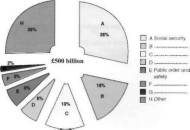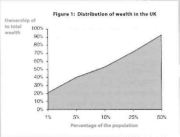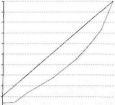ВУЗ: Не указан
Категория: Не указан
Дисциплина: Не указана
Добавлен: 18.10.2024
Просмотров: 240
Скачиваний: 1
Taxation, however, is not only a way tor a governmentto earn revenue. Through taxation, governments also achieve a number ot other things. Income tax. for example, should help to make the income gap between the rich and the poor smaller. Tax on harmful products like tobacco and alcohol should discourage people from consuming them. Finally, taxation is a way for the governmeut to control overall supply and demand in the market. For instance, a ver> high tax on a product will mean Jew jK-ople can buy it and therefore its market will be very small.
S> where does the money gor Revenue is generally spent on a combination of public services and something called transfer payments. Transfer payments are benefits that are given to families and individuals in society who need financial support. In Britain, transfer payments make up almost a third ot all public spending. These payments include sqfety net benefitssuch as unemployment benefit and social security benefits for families who do not have enough income to get by.
Most of the list of the revenue goes on publicgoods.These can be divided into two areas: pure publicgoo</s and mixed jnihlicgoor/.ч. Pure publicgotnlsare things like street lighting or national defence. These are important for everyone in a society, but they cannot be supplied by private business To understand why not. let's look at the example of street lighting. Lighting needs to 1ч- offered to everyone who uses the streets If a private business provided street lighting, they would need to charge for it. But how could they make everyone pay? Non-payers would benefit from the lighting, too. it would 1ч» impossible to stop them This is why a government, and not private businesses, offers street lighting: everyone pays for it through their taxi's.
54
Ни-
anGmdvreEronon-ct 'tip
Now read the text again and match each paragraph with the correct heading.
PARAGRAPH
PARAGRAPH '
PARAGRAPH i
PARAGRAPH 1
PARAGRAPH
The aims of taxation Services that businesses won't provide Providing what's good for us Providing social support Collecting income
Before you listen
Discuss the following with your partner.
The pie chart below shows how the UK government spends its revenue. Each segment of the pie (A to H) shows a different area of spending. The key shows what these areas are. Some labels are missing. Which of these areas do you think they are?
Defence
Education
Environment
Health care

B? F Listening H)))
Now listen and complete the chart. UK Government Spending: Where does the money go?
Discuss these questions with your partner.
In your opinion, what is more important for ar. economic system - equity or efficiency?
Do you think the tax system in your country is fair? Why / Why not?
Work in groups of four. Each of you has one of the following roles.
Finance Minister - you decide on how govornment revenue should be spent. Education Minister - you want more spending on education.
Talk about:
overcrowded classrooms lack of facilities teacher training Environment Minister - you want more spending on roads and public transport.
Talk about:
dangerous roads improving country roads increased underground train system free transport for retired people Health Minister - you want more spending on hospitals and health care.
Talk about:
cheaper medicine waiting lists in hospitals length of time to get a doctor's appointment hospital facilities Ministers: persuade the Finance Minister to give you more money. Finance Minister: ask questions to decide who needs more money.
Pronunciation guide Issue i[m
Consumption k.">ns\mpjn Equity /ekwirti Externality eksnrniebti Beneficial henifrjl Percentage ixvsentulv' Revenue 'ievonju: Taxation taekseifn
Write the following composition:'What is welfare economics and why is it important?'
First read through the texts again and make notes, then use the outline plan to organise your composition.
Composition
PARAGRAPH 1
Explain what welfare economics studies.
Points to include:
economics is not just numbers, economics with a heart, government policies affect society
Useful words and phrases:everyday lives, equity, externalities
PARAGRAPH 2
Say how economic relationships affect the welfare of a society.
Mention, these relationship»-.
Buyers and sellers how do prices affect people's lives?
Workers and employees how does work affect people's lives?
Factories and the environment what is the affect of the economy on our environment?
Useful words and phrases:cost of living, wages, working conditions, damage, pollution
PARAGRAPH 3
Explain how taxation can create equity m the economy.
Points to include:
What is equity?
How can taxation help to create equity? How can a tax system have vertical and horizontal equity?
Useful words and phrases:fairness, unfairness, income, distribute, wealth
PARAGRAPH4
Sum up by saying why you think welfare economics is important.
Points to include:
Importance of understanding how economics effects our lives.
Can economic policies make our lives better?
Useful words and phrases: to sum up. in my
view, helps us appreciate, impact, improve
Write 200-250 words
Hit m «0 £..iidc t о Uo>«" • » u»'t c> S5
a way of saving money for when you got old and stop working
things someone owns, but usually thmgs that can be moved
if you save money in a bank, you get this extra money for keeping it there
movement like a river
important or worth money
a collection or supply of tilings kept for later use

Before you read
Discuss these questions with your partner.
What do you think it means to be wealthy? Why are some people wealthier than others?
' A Vocabulary
Match the words and phrases with the definitions.
Valuable invest
pension scheme static
belongings flow
distribution
interest
savings
inequality
extent
56M ; « i (, >tdf rfl (tsron* c* Un t
to lend money to a company or bank in order to earn more money
how large or important something is
the way in which a supply of something, like money, is shared among people
money put somewhere for later use, for example in the bank
immobile, not moving unfairness

Wealth, income and inequality
What does it mean to he wealthy':The answer to this question varies from culture to culture. In the modernised, industrial world that we live in. wealth generally means all the collected ston of valuable things that belong to a person tor family, company or country). Wealth can include money saved in bank accounts, or invested in pension schemes. It can include land, houses or other property and valuable belongings such as works of art oi precious jewels Many people also own stocks and shares in companies. The various things that make up a person's wealth are often called и.чхег*.
So wealth is a static tiling. The term income, on the other hand, suggests aJlmc of money.Income is the amount of money that a person (or family or company) receives over a period of time. For most people, this means the salary they get for the work they do. However, there are other sources of income. < >ne source is government benefits, such as unemployment benefit or family support. Another source is rent from property and another is interest from savings.
Huge inequalities in wealth owned by individuals exist in many countries. Take the Tinted Kingdom for example. A fifth of all the marketable wealth is owned by just one per cent of the 1'K's population. That one per cent own over ^355 billion of assets. Figure 1 011page 56 shows how the rest of the I'tiitcd Kingdom's wealth is distributed. As you can see. the richest 50 per cent of the population own over 0Л per cent of the wealth. In other words, half the population own nearly all the wealth and the other half own only a tiny percentage. The chart also shows that the richest one per cent of the population ow n over a fifth of all the country's wealth
Large inequalities also exist in the distribution of income. The extent of these inequalities can be show n with something called the /.on us et/rtv. You can see an example in figure 2 below. The straight blue line shows perfectly equal distribution of income. For example, the bottom 2<" |vr cent earn 20 per cent of the total income The bottom 40 per cent earn 40 per cent and so 011. This is the ideal situation. The red curve, however, shows the real situation for the United
Kingdom. You can see immediately how far from perfect the distribution is. Half of the population, for example, earn just under a third of the total income. Move horizontally along the population line and you can see that 00 per cent of the Imputation take only 70 per cent of the total income. This means that the top ten per cent of the population earn nearly 30 |x-r cent of the country's total income.
^ В Comprehension
Now read the text again and match each paragraph with the correct heading.There are two extra headings that you don't need.
PARAGRAPH
PARAGRAPH 2
PARAGRAPHi
PARAGRAPH 4
How governments can create more equality Inequalities in income Inequalities in wealth What income is What wealth is
Why there are inequalities in wealth and income
Before you listen
Discuss the following with your partner.
Economic inequality also exists on a global scale. Below are some facts about global economic inequality. See if you can guess which figures from the box complete the notes.
^ 2/3 * 3 57 50 j
The lowest earning Americans have higher
incomes than (1) of the
world's population.
The world's richest (2) per cent
earn more than the combined income of the world's poorest (3) per cent.
0
1 1 1 1 1 1 1 r »
Ю
2030 40 M 80 70 ВС
90 100
fWlNtHI
»' tin p«»»lst'3?
100
Figure
21 Distribution of mcom« in the UK :l.or«nz Curves
dntf'-boik1'
the world have incomes that are more than the combined incomes of the poorest (5) countries in the world.
В С Listening H)))
I Now listen and check your answers.
M ft <m 1 M л G и' ft vt aF л r «. . • : 1 57
Before you read
Discuss these questions with your partner.
-» What does poverty mean? Is there a way to define it?
-» How many people in the world do you think live in poverty?
-» Do you believe people 111industrialised countries live in poverty?
Й D Vocabulary
Complete each sentence with a word or phrase from the box.
absolute associate average corruption cycle define generation m natural disasters shelter trap
We high crime rates with poverty
and unemployment.
Having a a roof over your head, is
a basic need of humankind.
Hew does the dictionary this word?
floods, droughts, hurricanes and other are happening more frequently.
Giving money secretly to judges or politicians so that they help you is an example of
Hunters will sometimes set a
instead of using agun.
Let's hope the next finally put an
end to hunger and poverty.
The world's water supply is a which
mvolves the sea. rainfall and rivers.
If somebody lives in poverty, that
means they are completely without money to buy basic necessities.
The salary at that company is
very high.
|
|
|
^ ГД Ж 1 ■■•алг _: яш |
|
|
|
|
^ 4 Zf Щ |
? t a '. »i |
|
|
|
|
Вми I |
Г» у иц.д*«. |
|
|
|
|
|
»* t - |
|
|

0 /
r *
Poverty
Without a doubt poverty is a huge problem in the world today, figures suggest that three billion 14'opk or half the world's population live in poverty However, although we associate poverty with developing countries, poverty of some kind also exists in industrialised nations lor example, it is now thought that quite possibly one in every ten Americans lives in (xivertуHowever, poverty means different things to different people. How do economists define poverty?

However, there ate one billion people in the world who live on lessthan one dollar a day. The World bank defines this as extreme f*rccrty.
l ew people in industrialised countries li\e in absolute poverty, but many live in relative [Miverry.This measure of poverty takes into account the differences that exist in a population Ivfween the rich and the poor. For example, some economists say that people who earn less than half the average income live in relative poverty In llritain. this means 1 i million people.
Whv doespoverty still i-\ist'rThere is no single answer to this question. In developing countries, causes oi absolute |x>verty include natural disasters like droughts and floods, political corruption and war. However, in many cases people and whole populations - are caught in .1 trap- the poverty trap
I'eople on a low income spend everyllling they have on dailv necessities.They save almost nothing. In order to raise themselves out of poverty, they need education. This costs money. Kvcll when governments provide free schooling,tinpoor may not send their children because they need them to work These families cannot afford the cost of sending a child to school. Without education, the children cannot find better paid work. In this way, generations of the same family remain p< >or.
The same cycle that traps individuals can trap a whole j*>pulation Kconomic growth dejKiids on investment. Investment money conies from sav ings. Л nation that has almost no savings cannot grow economically. This keeps wages low. soagain |>cople cannot save and the cycle continues
^ E Comprehension
Now read the text again and answer the questions.
Poverty is ...
only found in developing countries, mostly in industrialised countries, found in both developing and industrialised countries
What number of people live in extreme poverty? three billion two billion one billion
How can relative poverty be explained? It takes into account that there are rich people.
It's a kind of poverty found in industrialised countries.
It's a kind of poverty only experienced in Britain.
What cause of poverty is tu>t mentioned in the text? war
lack of natural resources natural disasters Why can't people escape from the poverty trap? Because they refuse to send theu children to school.
Because they need any income their children can earn.
Because governments don't provide free education. According to the text, why arc countries often trapped in a poverty cycle?
There is no money for investment.
There are no schools.
The land is not good for growing crops.
Before you listen
Discuss these questions with your partner.
What do you think ares the possible results of living in poverty?
-* In what ways does poverty affect people's lives?
F F Listening Ц)))
Now listen and complete the notes. Health
Poor people (1) younger.
Life expectancy is (2) years
shorter.
(3) is more common.
Family
Teenage girls are more likely to (4)
) are more common.
) rates are higher.
Education and training
Mi
i G t. 1 * t ► • 59
No (8) at work.
G Speaking
Discuss this question with your partner.
Do you think it is possible to share wealth equally?
Give a two-minute talk on the subject of poverty.First read text 2 again and make notes below on the following.